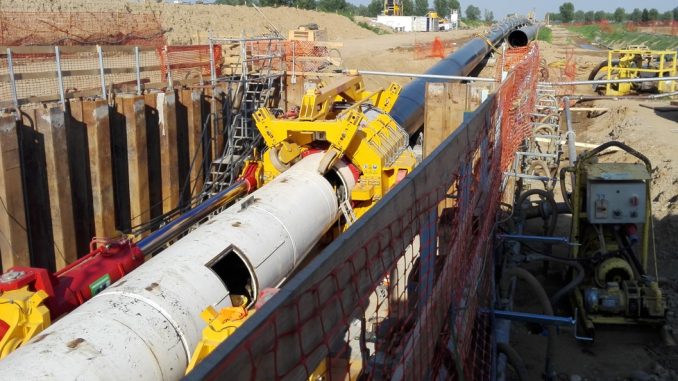
Trenchless pipe installation is growing in popularity across the world. The technology allows vast pipelines many kilometres in length to be installed with minimal surface disruption, by avoiding the need to dig trenches or carry out excavation to bury pipes underground.
There are several trenchless installation techniques, but all essentially involve pulling a fully-fabricated pipeline through the ground.
With trenchless pipe installation, no more than two holes need to be dug – a shaft at the start of the pipeline and a shaft at the end.
Using just two holes and carrying out the laying of the pipeline underground means that installation does not involve digging up huge swathes of land.
Pipelines can be installed under roads, railway lines, rivers, buildings and even entire cities. Trenchless installation requires less space and therefore reduces the chances of interfering with existing utilities, like electric cables.
Here are six of the most common forms of trenchless pipe installation.
Horizontal directional drilling
Horizontal directional drilling (HDD) installs underground pipelines made of different materials and diameters up to 350mm. It can install around 250 metres of pipeline at a time, passing underneath motorways, railway lines, rivers and infrastructure above-ground.
Water mains, wastewater pipes, oil lines and gas pipes can all be installed using horizontal directional digging. Away from pipes, the method is also used for underground cables and ducts.
There are three stages to horizontal directional digging. The first involves drilling a pilot hole into the ground and along a predetermined underground path.
The second stage sees the initial borehole enlarged by pumping in drilling fluid. The drilling fluid grinds down the soil and carries cuttings back to the entrance of the borehole.
How long it takes to enlarge the hole is dependent on soil conditions, the length of the borehole and the width to which it has be to widened before the pipe is installed.
The completed pipeline is then pulled through the borehole for stage three of the installation process, where it sits ready to be connected.
One downside to horizontal directional digging is that it is an intense process. Pipelines can suffer abrasion, impact damage and scarring as they are dragged underground.
To prevent this, pipes being installed using horizontal directional digging are protected with brushable epoxy coatings, shrink sleeves, protective tapes and specialist fibreglass composite wrap for pipe and weld protection.
The versatility of horizontal directional digging in terms of the different types and sizes of pipeline it can be used to install make it one of the most popular forms of trenchless technology.
Impact moling
Impact moling is used for the installation of smaller pipelines up to 150mm in diameter over shorter distances of up to 60 metres.
The installation takes place at a depth of one metre below the surface or 10 times the diameter of the pipe, whichever is greater.
Two vertical pits are dug at either end of where the pipe is to be laid. A pneumatic hammering tool known as an impact mole is then positioned in one shaft facing across to the other.
When the compressor in the mole is activated, it advances in a straight line to create a borehole from one pit to the other.
Once the borehole has been created, the pipe is dragged through. Impact moling has low costs, causes minimal disturbance and takes less installation time than other forms of trenchless pipe installation.
Auger boring
Auger boring involves drilling two vertical shafts and jacking a steel casing through the ground between the pits. Earth is removed from inside the steel casing using a rotating auger, which sends the soil through to one of the shafts for removal.
Once the auger has done its work and excavated the soil, a pipeline is left connecting the two pits. Boreholes of huge diameters can be created using auger boring.
This makes it a popular trenchless pipe installation technique for the construction of sewer ducts and major infrastructure pipelines passing beneath buildings.
Microtunnelling
Microtunnelling uses a remote controlled steerable bore to install huge pipelines in a single pass via pipe jacking. The boring machine is operated by a user on the surface, who guides the automatic steering system through the ground.
Soil is removed either by vacuum, slurry or a rotating auger, as with auger boring. As the microtunnelling boring machine drills through the ground, a jackhammer pushes the pipe into place between the machine and the jacking rig.
The steering system enables highly accurate boreholes to be created over very long distances, including curved lines.
Pipe diameters ranging from 1 to 3 metres can be installed via microtunnelling, making it ideal for boring deep gravity sewers and mains water lines underneath towns and cities.
Microtunnelling also provides an alternative to horizontal directional drilling when the ground is too unstable to take HDD.
Pipe ramming
Pipe ramming is a trenchless pipeline installation technique involving no use of drilling fluids or over-excavation. It literally rams a pipe through the ground.
This is achieved by digging two pits. A percussion hammer is attached to the end of the pipe to be installed. The front of the pipe is then aligned in the direction it is to travel.
An air compressor drives the pipeline through the soil from one pit to the other. Sometimes, guide rails are needed to maintain the correct path.
Pipe ramming offers less accuracy compared to other techniques. It does though permit the installation of larger pipes in a wide range of soil conditions.

Leave a Reply